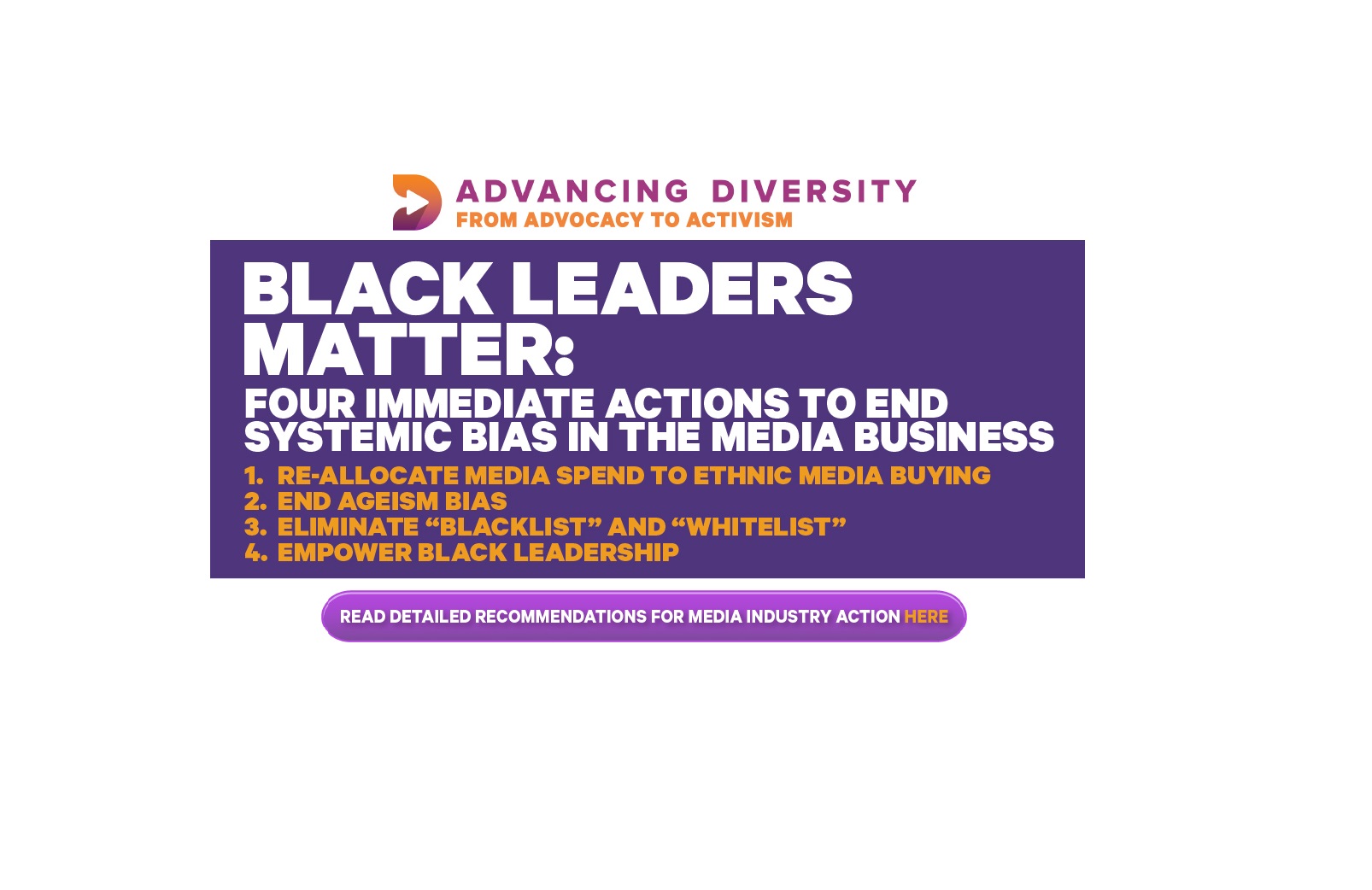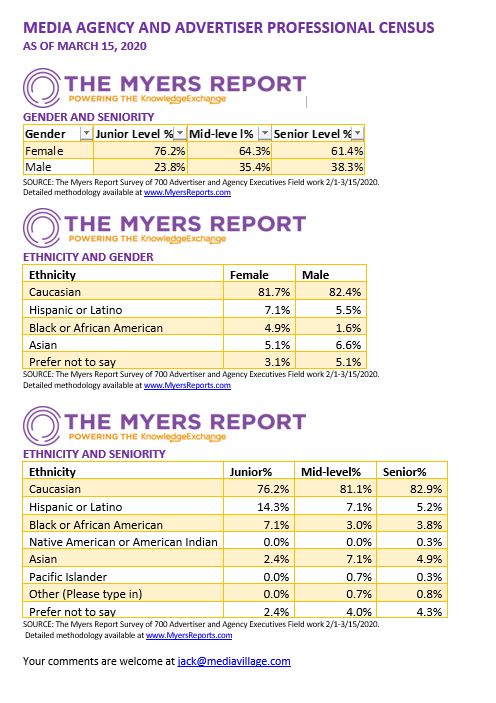Black Leaders Matters: Four Immediate Actions to End Systemic Bias in the Media Business

In this article, I advance four immediately applicable specific actions that can be taken to help end the systemic bias that permeates the media and advertising business. Through these actions, the media and advertising community can take action steps toward cultural and business leadership, immediately reverse flawed business models that are a negative drag on growth, and uproot the conscious and unconscious racism that is deeply engrained across our society, culture, politics, business world and advertising community.
Since the launch of AdvancingDiversity.org and the Advancing Diversity Hall of Honors in 2017, our mantra has been Advancing Diversity from Advocacy to Activism. As we move beyond talk to action, our founding principles need to take a giant leap forward once again, and shift To Activism and Results. We must no longer confuse laurels, honors, awards, financial contributions, and industry accolades, presented mostly to Anglo-executives, with results-driven leadership. Here are four immediately measurable actions recommended by AdvancingDiversity.org. I call on leaders to implement -- and require the implementation of -- these four recommendations across their supply chain.
- RE-ALLOCATE MEDIA SPEND TO APPROPRIATELY (AND DISPROPORTIONATELY) VALUE ETHNIC MEDIA
Shift media budgets to BET, TV One, Univision, Telemundo, Essence, OZY and other ethnically focused media companies. In the process, correct the systemic cost-per-thousand inequities these media organizations have long been forced to accept. The long-standing systemic bias against ethnic media should be ended today by a long-overdue recalibration of media plans. Take similar actions to support media that represent other under-served communities. Procurement teams must align cost efficiency requirements with corporate responsibility to acknowledge the appropriateness of reparation-based over-investment in ethnic media.
- END AGEISM BIAS IN MEDIA BUYING
If the consumer target demographic is 55+, media buying criteria should transparently and honestly reflect that demo.As reported extensively at MediaVillage's Age of Aging column, media buying organizations have historically excluded the 55+ demographic from media buys. They drive down the value of media that over-index on 55+ audiences by forcing them to base pricing on their smaller 25-54 audience delivery, even when the actual consumer target identified by their clients is well beyond age 55. This is, at best, deceitful and non-transparent and, at worst, unethical and blatant ageism. With the growing availability of addressable targeting based on consumer purchase and media consumption patterns, brand marketers must demand that media buys are inclusionary and not exclusionary of their core targets. Procurement teams must align cost efficiency requirements with corporate responsibility.
- ELIMINATE "BLACKLIST" AND "WHITELIST" FROM LANGUAGE AND FROM MEDIA BUYS
Ebony and ivory live together in perfect harmony
Side by side on my piano keyboard, oh Lord, why don't we?
We all know that people are the same wherever you go
There is good and bad in ev'ryone
We learn to live, when we learn to give
Each other what we need to survive, together alive
Stevie Wonder, Paul McCartney
Brand marketers have the right to delete websites and media content from their media buys based on any number of criteria. Those criteria should not include race, creed, or color. The first step is to eliminate the unconscious bias built into the language of "blacklist" and "whitelist." "Black vs. white" as synonyms for "evil vs. good" is embedded in culture and identity. We can start with the simple elimination of content 'whitelists' and 'blacklists', changing the descriptions to 'accepted' and 'rejected' or some other equally relevant terms. Marketers and agencies need to immediately and publicly reject the exclusion of media content based on the ethnicity or gender preferences of their audiences. As media plans shift away from traditional demographics and toward consumer purchase behavior, age, gender, and ethnicity should be actively eliminated from planning parameters. They are vestiges of outdated norms that are not only irrelevant in modern society, they empower and advance bias. The Civil Rights Act of 1964 rejects them. "Title VI prohibits discrimination on the basis of race, color, or national origin. Simply stated, all persons [and corporations are legally considered persons] must be treated equally. People may not be excluded from participating in, denied the benefits of, or discriminated against in programs, services, or activities." There are caveats based on acceptance of federal funding, which most companies have accepted in the form of tax benefits and Covid-19 financial support. But let's not debate technicalities. Bias is bias. Let's eliminate it now in the media buying parameters set by brands and agencies and accepted by content publishers and distributors.
- EMPOWER BLACK LEADERSHIP
This topic is covered extensively in the data charts below and at AdvancingDiversity.org – The Black/White Divide. At all levels of management below CEO, females are well-represented in the media community. As noted in The Myers Report data charts below, males constitute 35% of media agency professionals and fewer than 25% of junior media agency personnel. Only 1.6% -- that's not a typographical error – of males in the media agency business and 5.0% of females are Black. Seventeen percent of females and 13.7% of males are ethnically diverse.
As extensively reported by AdvancingDiversity.org and other diversity organizations, the advertising industry's greatest talent concern is retention and the support provided to assure diverse talent not only joins our community, but has positive experiences, gains relevant knowledge, builds meaningful relationships, and sees a positive future for themselves and their opportunities for success. Based on these standards, we are failing as an industry.
The immediate solution is to proactively and immediately move diverse professionals into positions of responsibility, authority, and visibility. From my work over the past decades, I've built relationships with several Black executives who perform successfully, have built all the credentials for leadership, but whose career have stagnated as others rose above them into the top corporate ranks. I can identify several in our business today who are aligned for senior positions, but who even at this historic moment are not being elevated. Moving Black executives into senior roles of authority and responsibility is a societal, cultural, and business imperative. A failure to recognize and immediately promote these highly qualified leaders – now – will negatively resonate on each company and our industry for decades.
If there are no Black leaders to elevate, it calls attention to an even greater corporate concern – one that demands hiring action. It's an outdated and flawed arrogance to believe that only those who've built their careers within our closed ranks are deserving of executive responsibility. If, within your organization, you're unable to identify Black team members deserving of leadership, hire them now. If necessary, look outside of our immediate community. Covid-19 economics notwithstanding, the future of your business and our shared business interests are at stake. At MediaVillage, we're in active conversations to assure Black leaders are positioned for rapid elevation to senior roles. Every company should be on the same path.



